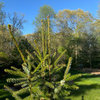This from "IN THE GARDEN; From the Jurassic to the Patio" by ANNE RAVER in the N.Y. Times (February 8, 2007) on the Wollemi pine:
"I WENT to the Plant-O-Rama, the annual horticultural hoo-hah at the Brooklyn Botanic Garden, in search of new plants two weeks ago, and fell in love with one of the oldest on earth: the Wollemi pine, which grew among the dinosaurs 200 million years ago.
"The three-footer was sitting in a pot at the edge of the Trail of Evolution at the Steinhardt Conservatory, where algae and liverworts, horsetails and club mosses -- early plants of the Paleozoic era -- lead to the ferns and cycads that flourished in the Jurassic period.
"'Nobody thinks about this, but the dinosaurs all died, and many of the plants that grew alongside them continued to evolve and live on this planet today,' said Scot D. Medbury, the president of the Brooklyn garden, as we stared at the potted pine sitting next to its cousins, a potted Norfolk Island pine, a prickly bunya-bunya and a hoop pine.
"'It's a cool thing to bring them together, a family reunion, in a sense,' Mr. Medbury said.
"The little potted Wollemi pine is so graceful, it appears to be dancing. Its blue-green needles are flat and smooth, and evenly spaced down either side of long, pendulous branches that extend toward the floor before turning up, ever so slightly, at the ends.
. . . .
"And those pendulous branches, lined with long flat needles, were that way for a reason: 'to get as much surface area as possible towards the light, which was very low in Gondwana,' Ms. Chandler said."
A couple of questions occur.
First, why was the light low in these primaeval times? Was there intense cloud cover, with direct light coming under the cover in morning and at dusk?
Second, note that other very old species (other than within the Araucariacae family) have a similar configuration. I'm thinking of the Cunninghamia. Are there others?
Third, when the light angle changed, why did these species not evolve further to be better adapted to the new angle?















pineresin
pinetree30
Related Professionals
Marina Landscape Architects & Landscape Designers · Milwaukee Landscape Architects & Landscape Designers · Salisbury Landscape Architects & Landscape Designers · Allentown Landscape Contractors · Gainesville Landscape Contractors · Tempe Landscape Contractors · Beverly Hills Landscape Contractors · Bound Brook Landscape Contractors · Centereach Landscape Contractors · Fairview Landscape Contractors · Kaysville Landscape Contractors · Mason Landscape Contractors · New Berlin Landscape Contractors · Tacoma Landscape Contractors · West Chester Landscape Contractorslucy
Fledgeling_
arauquoiaOriginal Author
noki